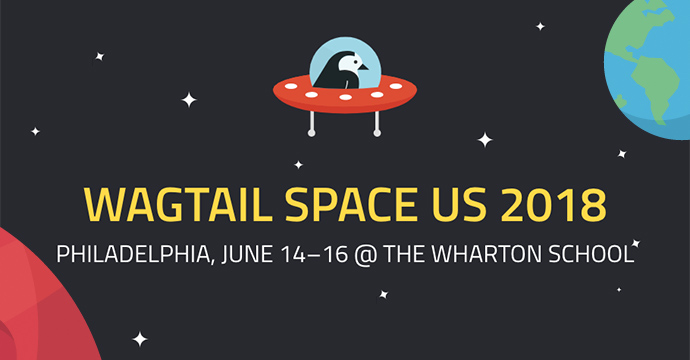This month, I attended and presented at the first Wagtail Space conference/sprint in the USA. Wagtail Space USA, led by the parent company Torchbox, took place on June 14th–16th at the Wharton School at the University of Pennsylvania. There were presentations by Wagtail CMS developers and users, tutorial and lightning talks, and a sprint throughout the three-day event.
Wagtail is an open source content management system by Torchbox, written in Python and built on the Django framework. We have been experimenting with Wagtail CMS on the forthcoming CTL Portfolio, and are quite pleased with the framework. Wagtail Space USA was an opportunity for us to see what other groups are doing with the CMS, and meet to exchange ideas and share experience. I presented the process the DevTeam went through that led us to choosing Wagtail CMS as one of the tools for us to use at the CTL. My talk was recorded and now up on YouTube.
There were over sixty attendees from tech companies, NGOs, universities, and government agencies. This shows that Wagtail appeals to a wide base across industries. Many switched to Wagtail because they were dissatisfied with popular platforms like Drupal and WordPress. We seemed to share common reasons why Wagtail is a much more viable alternative: it is flexible, configurable, and has strong support in the open-source community.
The presentations were by representatives from a variety of industries. The talks are now on YouTube, and here are my summaries of each:
- Tom Dyson, the Director at Torchbox, shared the history of Wagtail, delivered the state of “Wagtail in 2018,” and the future directions the company will pursue for Wagtail given its growing popularity. Some of the possibilities include improving the editorial workflow and accessibility, and using machine learning services to support editors’ tasks such as image recognition and natural language processing.
- Lacey Williams Henschel, a software engineer from REVSYS suggested ways to improve and reorganize Wagtail documentation in her talk, “What the Wagtail Docs Don’t Tell You”
- Using log messages can be beneficial for development of sites and application using Wagtail. In his talk, “Django Logging for Wagtail” Ryan Sullivan, a developer from Wharton Research Data Services (WRDS), University of Pennsylvania shared some examples on how logs were used to trace block renderings, debug templatetags, and look at how and when methods were being called.
- Lisa Adams and Codie Roelf from the Praekelt Foundation (South Africa) shared how they used Wagtail to develop and scale mobile (with multilingual support!) sites and applications across the globe, “Scaling Wagtail for 100 Million Girls.” Codie Roelf emphasized the FOSS nature of Wagtail in a different, but important, perspective, “When you contribute to Wagtail, you not only contribute to the code base of a CMS, you contribute to the well-being of millions of girls.”
- In his talk “Wagtail in the Cloud,” Daniele Procida of Divio demonstrated how to quickly launch a Wagtail site (front- and back-end) on Divio’s Wagtail cloud. Divio’s cloud platform is particularly useful for those who would like to deploy and use Wagtail without going through the process of setting up and deployment. Divio is also the company backing djangoCMS, another Django-based framework.
- Ryan Verner’s company, StocksDigital, provides website and CMS solution for newsrooms. His presentation, “Running a Multi-Site Newsroom in Wagtail,” showed the challenges of fitting workflow, editing process, and content versioning to unique newsrooms’ path that journalists follow—articles being rapidly reviewed and edited in parallel, inline commenting, juxtaposition of versions. Wagtail provided some relief, however, the incompatibilities still exists. He also talked about using the CMS to streamline the delivery of news articles via templates for different views (AMP, Apple News, etc).
- The Freedom of Press Foundation is using Wagtail to fight for press freedom, as presented by Harris Lapiroff. Lapiroff showcased interesting ways he used Wagtail for the crowdfunding widgets, and for content management in other FPS projects such as the U.S. Press Freedom Tracker.
- Python developer Michael Harrison talked about how he set up Wagtail as a headless CMS for OpenStax at Rice University. My personal take: this is something very awesome that I know very little about, so I let Wikipedia explain what headless CMS is.
- What type of Wagtail learner are you? Developer Dawn Wages explained the different types of learning approaches using her fun species classification of a beginner Wagtail-er, “Learning Wagtail.” I might be the ”Scared-a-lot-o-don.”
- Government agencies are also using Wagtail. Andy Chosak from Consumer Financial Protection Bureau talked about the benefits of open-source community and contributions, and encourages some best practices to doing so: “Sharing is Caring: Contributing to the Wagtail Ecosystem.”
I also attended a Wagtail tutorial at the conference to learn anything that I might have missed in my own experiment with the CMS. I finally figured out how powerful Streamfield can be, and how free formatting of content in text can be a bad idea. But this is a topic for another post.
There was also a sprint session after the talks, for developers to code submit their contribution to core Wagtail, and listed in Awesome Wagtail. I certainly received good ideas and suggestions for improvement for my own use of Wagtail in my CTL project. Collaboration is possible with strangers, when the goal is for the good of free and open-source software.
Lightning talks given by multiple developers took place after the sprint. It is interesting to hear how people are using this CMS in social activism as well, and for causes that aim to improve the health and wellbeing of the community.
Links and resources
- Wagtail site
- Made with Wagtail
- Wagtail on Github
- Awesome Wagtail — A curated list of packages, articles, and other resources from the Wagtail community.
- Wagtail Bakery demo — A demo online to try out Wagtail
- How CTL DevTeam choose Wagtail CMS
Printed from: https://compiled.ctl.columbia.edu/articles/wagtailspace-us-event/

